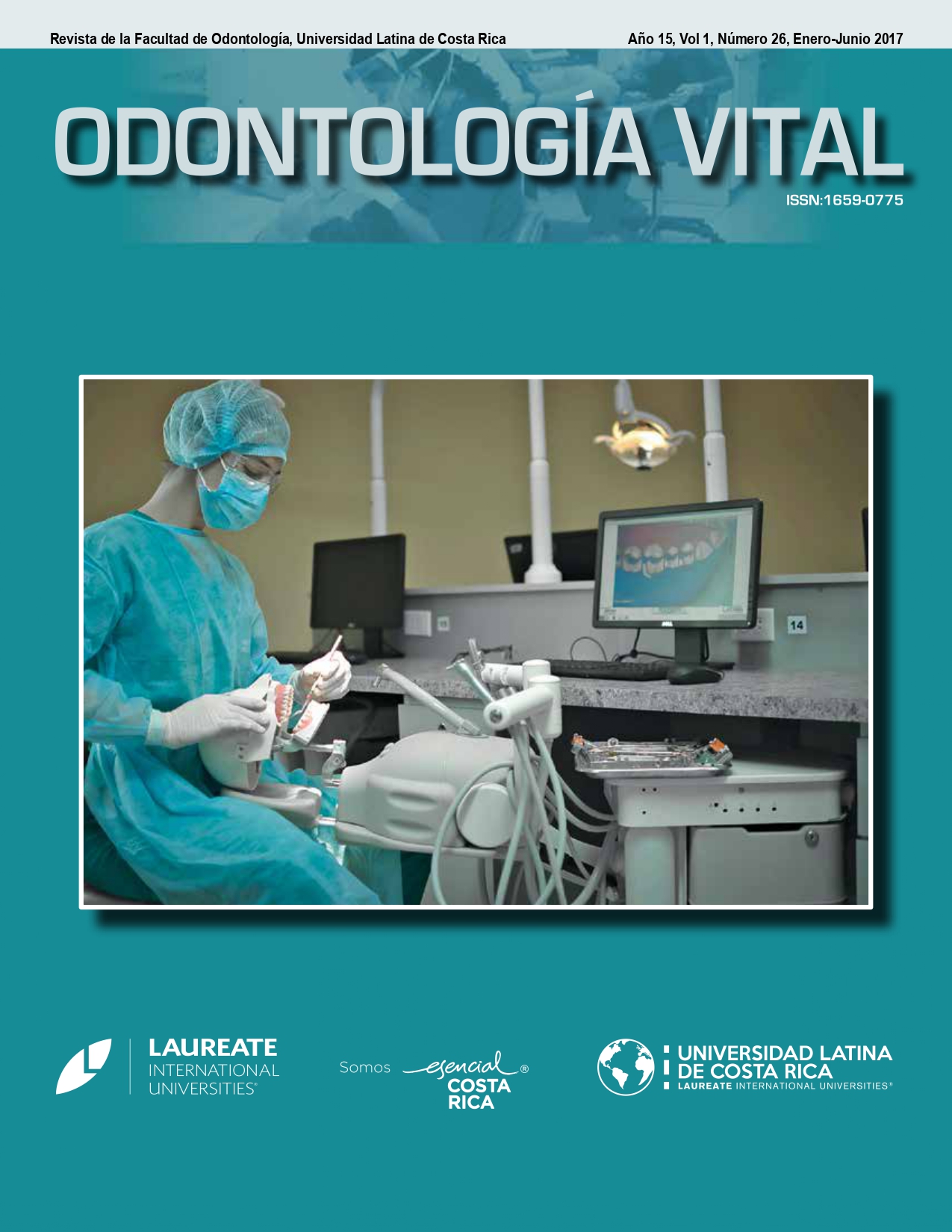Endoimplant with NiTi file: novel solution to an old root complication
DOI:
https://doi.org/10.59334/ROV.v1i26.219Keywords:
Dental trauma, root dilaceration, apicoectomy, endodontic stabilizer implant, endoimplantAbstract
The dental trauma is a common problem in daily practice not always handled properly. This article describes the case of a patient who received an early knock that affected radicular development of tooth 1.1. Eventually a number of complications appeared such pulp necrosis, coronal pigmentation, presence of large perialpical lesion and recurrent appearance of fistula, which led the patient to realized a series of treatments that eventually failed until 37 years later, through advances in technology, it was possible to solve the case by making an apical surgery with placement of an endoimplant with a nickel titanium (NiTi) file. This case shows that with the passage of time, the desire of the patient to keep teeth in her mouth and the appearance of new materials and techniques, nowadays, highly complex cases that would normally be destined for extraction can be solve.
Downloads
References
Andreasen, JO., Sundstrom, B., Ravn, JJ.. (1971). The effect of traumatic injuries to primary teeth on their per-manent successor. I. A clinical and histologic study of 117 injured permanent teeth. Scand J Dent Res;79:219–83. https://doi.org/10.1111/j.1600-0722.1971.tb02013.x
Andreasen, JO..(1976). The influence of traumatic intrusion of primary teeth on their permanent successors. A radiographic and histological study in monkeys. Int J Oral Surg;5:207–19. https://doi.org/10.1016/S0300-9785(76)80016-6
Berman, L. H., Blanco, L. P., & Cohen, S. (2007). A clinical guide to dental traumatology. St. Louis, Mo: Mosby/ Elsevier. https://doi.org/10.1016/B978-0-323-04039-6.50010-X
Borssen, E., Holm, AK., (1997), Traumatic dental injures in a cohort of 16 years- old in northern Sweden, Endod Dent Traumatol 13:27. https://doi.org/10.1111/j.1600-9657.1997.tb00055.x
Bruno, J.A., (1954). Estabilización Intraósea, alcance y limitaciones de la técnica desde el punto de vista anatómi-co. Reflexiones sobre el arte quirúrgico. Odont Uruguaya,8:311-25, mayo-junio 1954b.
Cortés, MIS., Marcenes, W., Sheiham, A., (2002). Impact of traumatic injuries to the permanent teeth on the oral health realted quality of life in 12 – 14 year old children. Community Dent Oral Epidemiol; 30: 193-8. https://doi.org/10.1034/j.1600-0528.2002.300305.x
Cranin, AN., Rabkin, MF., Garfinkel, L. (1997). A statistical evaluation of 952 endosteal implants in humans. J Am Dent Assoc;94:315–320. https://doi.org/10.14219/jada.archive.1977.0288
Crescini, A., Doldo, T.. (2002). Dilaceration and angulation in upper incisors consequent to dental injuries in the primary dentition: orthodontic management. Prog Orthod;3:29–41. https://doi.org/10.1034/j.1600-9975.2002.00017.x
Da Silva, AC., Passeri, LA., Mazzonetto, R., De Moraes, M., Moreira, RW., (2004). Incidence of dental trauma asso-ciated with facial trauma in Brazil: a 1 – year evaluation, Dent Traumatol 20: 6.
Feldman, M. y Feldman, G. (1992). Endodontic stabilizers. JOE, vol. 18, no. 5, mayo 1992. 245-248 pp. https://doi.org/10.1016/S0099-2399(06)81268-9
Frank, AL.. (1967). Improvement of the crown root ratio by endodontic endosseous implants. J Am Dent Assoc ; 74:451-62. https://doi.org/10.14219/jada.archive.1967.0083
Goldberg, F.. (1982). Endodontic implant: a scanning electron microscopic study. Int Endodon J.; (15), 77-8. https://doi.org/10.1111/j.1365-2591.1982.tb01345.x
Ingle, J., Bakland, L., (1994). Endodoncia. Editorial Mc Graw-Hill Interamericana México,pags 794 – 796.
Madison, S., Bjorndal, AM., (1988). Clinical application of endodontic implants. J Pros Dent;59:603-608. https://doi.org/10.1016/0022-3913(88)90079-0
Mendoza, A., García, C., (1960). Traumatologia oral en odontopediatría. Editorial Océano. España.
Orlay, HG., (1960). Endodontic splinting treatment in periodontal disease. Br Dent J ; 108:118-21.
Pereira, FR., Brawuel, JD., Roahen, JO., Giambarresi, L.. (1996). Histological response to titanium endodontic en-doosseous implant in dogs. J. Endod. ; 22(4):161-4. https://doi.org/10.1016/S0099-2399(96)80092-6
Prasad, K., (2010). Improvement of crown root ratio by using regular endodontic stainless steel instruments: a case report. Indian J Stomatol ;1(2), 100-102.
Rivera Briones, M.A., y Solano Robles, R.(2000). Estabilizadores endodóncicos, casos clínicos, revisión bibliográfi-ca. Práctica odontológica. vol. 21, no. 7. 12-16 pp.
Souza, Malaquías. (1954). El uso de estabilizadores intraóseos en apicectomías y en órganos paradentósicos. Rev. Asoc.Odontológica Argentina.42:325-41,Ag .
Strock, AE,, Strock, MS.. (1943). Method of reinforcing pulpless anterior teeth-preliminary report. J Oral Surg ; 1:252-5.
Sussman, H., Moss, S., (1993). Localized osteomyelitis secondary to endodontic-implant pathosis. J Periodontol 64:306-10. https://doi.org/10.1902/jop.1993.64.4.306
Valdivia, J.E., Salas, E., Hernández, F., (2012). NiTi endodontic intraosseous implant. Dental Press Endod. Jan-Mar;2(1):38-41
Weine, FS., (1996). Endodontic therapy. 5th ed. St. Louis: Mosby Publications: 666-73.
Yadav, RK, Tikku, AP, Chandra, A, Wadhwani KK, A, Singh, M. (2014). Endodontic implants. Natl J Maxillofac Surg; 5:70-3. https://doi.org/10.4103/0975-5950.140183
Downloads
Published
Issue
Section
License
Copyright (c) 2017 Mariela Barzuna P, Mayid Barzuna U

This work is licensed under a Creative Commons Attribution 4.0 International License.
Authors who publish with Odontología Vital agree to the following terms:
- Authors retain the copyright and grant Universidad Latina de Costa Rica the right of first publication, with the work simultaneously licensed under a Creative Commons Attribution 4.0 International license (CC BY 4.0) that allows others to share the work with an acknowledgement of the work's authorship and initial publication in this journal.
- Authors are able to enter into separate, additional contractual arrangements for the non-exclusive distribution of the Odontología Vital's published version of the work (e.g., post it to an institutional repository or publish it in a book), with an acknowledgement of its initial publication.
- Authors are permitted and encouraged to post their work online (e.g., in institutional repositories or on their website) prior to and during the submission process, as it can lead to productive exchanges, as well as earlier and greater citation of published work.







